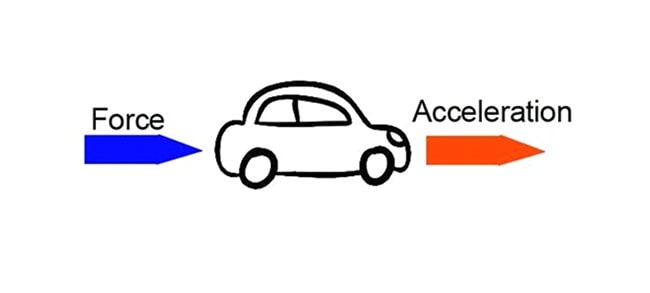Acceleration Meaning
Acceleration is the consequence of the verb “accelerate,” a word of Latin origin, coming from “celer,” which means “to go faster.”
In Physics, acceleration is the change in the speed of a body in a given time. It is necessary to know its direction, magnitude, and sense because it is a vector magnitude that establishes a relationship between the variations in speed and the time it takes for them to occur. In the international system, the unit is m/s2. It is measured with an accelerometer. What acceleration indicates is how fast the changes in speed occur and not the speed itself. An object can move very quickly and not have much acceleration. If the speed is constant, the acceleration is equal to zero, even if it moves quickly. Negative acceleration is called deceleration. This happens, for example, when a vehicle brakes. The movement is uniformly accelerated if the increase is proportional to time.
The relationship between changes in direction and the time in which they occur is called centripetal or normal acceleration, which means that a body accelerates if it changes direction since it cannot change direction without the presence of some acceleration. Bodies that are not accelerated always follow a straight line and never a curve. The relationship between speed and time is centrifugal acceleration.
The average acceleration, considered as a time interval, is given by the quotient between the increase in speed experienced in that time and the amplitude of this increase. When the time considered is so short that we can reduce it to an instant, we speak of instantaneous acceleration, and it is given by the quotient between the increases in speed and the time.
The acceleration of gravity is what causes the movement of the planet Earth, due to the force of gravity.
Acceleration Meaning in Hindi
त्वरण(Acceleration) क्रिया “त्वरित” का परिणाम है, जो लैटिन मूल का शब्द है, जो “सेलर” से आया है, जिसका अर्थ है “तेज़ चलना।”
भौतिकी में, त्वरण किसी दिए गए समय में किसी पिंड की गति में होने वाला परिवर्तन है। इसकी दिशा, परिमाण और अर्थ जानना आवश्यक है क्योंकि यह एक सदिश परिमाण है जो गति में होने वाले परिवर्तनों और उनके होने में लगने वाले समय के बीच संबंध स्थापित करता है। अंतर्राष्ट्रीय प्रणाली में, इकाई m/s2 है। इसे एक्सेलेरोमीटर से मापा जाता है। त्वरण यह दर्शाता है कि गति में परिवर्तन कितनी तेज़ी से होते हैं, न कि गति स्वयं। कोई वस्तु बहुत तेज़ी से आगे बढ़ सकती है और उसमें बहुत अधिक त्वरण नहीं हो सकता। यदि गति स्थिर है, तो त्वरण शून्य के बराबर होता है, भले ही वह तेज़ी से आगे बढ़े। नकारात्मक त्वरण को मंदी कहा जाता है। ऐसा तब होता है, उदाहरण के लिए, जब कोई वाहन ब्रेक लगाता है। यदि वृद्धि समय के समानुपातिक है तो गति समान रूप से त्वरित होती है।
दिशा में परिवर्तन और जिस समय में वे घटित होते हैं, उसके बीच के संबंध को अभिकेन्द्रीय या सामान्य त्वरण कहा जाता है, जिसका अर्थ है कि यदि कोई पिंड दिशा बदलता है तो उसमें त्वरण होता है क्योंकि वह बिना किसी त्वरण की उपस्थिति के दिशा नहीं बदल सकता। जो पिंड त्वरित नहीं होते वे हमेशा एक सीधी रेखा का अनुसरण करते हैं और कभी वक्र का नहीं। गति और समय के बीच का संबंध केन्द्रापसारक त्वरण है।
औसत त्वरण, जिसे समय अंतराल के रूप में माना जाता है, उस समय में अनुभव की गई गति में वृद्धि और इस वृद्धि के आयाम के बीच के भागफल द्वारा दिया जाता है। जब माना जाने वाला समय इतना छोटा होता है कि हम इसे एक पल में घटा सकते हैं, तो हम तात्कालिक त्वरण की बात करते हैं, और इसे गति में वृद्धि और समय के बीच के भागफल द्वारा दिया जाता है।
गुरुत्वाकर्षण का त्वरण गुरुत्वाकर्षण बल के कारण ग्रह पृथ्वी की गति का कारण बनता है।

